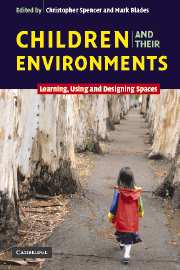Book contents
- Frontmatter
- Contents
- Notes on contributors
- An introduction
- Part I Children's understanding of places
- Part II Children's experience of places
- 5 Learning neighbourhood environments: the loss of experience in a modern world
- 6 The classroom environment and children's performance – is there a relationship?
- 7 ‘Sometimes birds sound like fish’: Perspectives on children's place experiences
- 8 Is contact with nature important for healthy child development? State of the evidence
- 9 Environmental child-friendliness in the light of the Bullerby Model
- Part III Adolescents' worlds?
- Part IV Children and the design process
- Index
- References
7 - ‘Sometimes birds sound like fish’: Perspectives on children's place experiences
Published online by Cambridge University Press: 23 October 2009
- Frontmatter
- Contents
- Notes on contributors
- An introduction
- Part I Children's understanding of places
- Part II Children's experience of places
- 5 Learning neighbourhood environments: the loss of experience in a modern world
- 6 The classroom environment and children's performance – is there a relationship?
- 7 ‘Sometimes birds sound like fish’: Perspectives on children's place experiences
- 8 Is contact with nature important for healthy child development? State of the evidence
- 9 Environmental child-friendliness in the light of the Bullerby Model
- Part III Adolescents' worlds?
- Part IV Children and the design process
- Index
- References
Summary
Over the past few years, studies of children's environments have increasingly recognized the variation in children's experiences in shaping their learning, social development, and play (Holloway and Valentine, 2000; Matthews et al., 2000a; Matthews et al., 2000b; Punch, 2000). These studies remind us that children who grow up within a particular physical environment will not all share the same experiences or emotional responses to a place. Punch (2000) emphasizes that children themselves play a significant role in shaping their own experiences even within similar physical and social environments.
With the recognition that children shape their own place experiences has come a growing number of studies with children in urban environments (Berg and Medrich, 1980; Katz, 1993; Kong, 2000; Lynch, 1997; Moore, 1986; Ward, 1978), rural environments (Derr, 2001; Hart, 1979; Jones, 2000; Matthews et al., 2000a; Nabhan and St Antoine, 1993; Punch, 2000; Sobel, 1993; Ward, 1990), and within a variety of cultural contexts (Beazley, 2000; Derr, 2001; Katz, 1993; Kong, 2000; Matthews, 1995; Punch, 2000; Robson, 1996). As this body of literature continues to grow, some trends emerge as to the importance of these places in children's development. In this chapter I develop these trends through a framework that emerged from my own research with children, aged nine to eleven, living in rural and urban towns of northern New Mexico in the United States.
- Type
- Chapter
- Information
- Children and their EnvironmentsLearning, Using and Designing Spaces, pp. 108 - 123Publisher: Cambridge University PressPrint publication year: 2006
References
- 22
- Cited by



